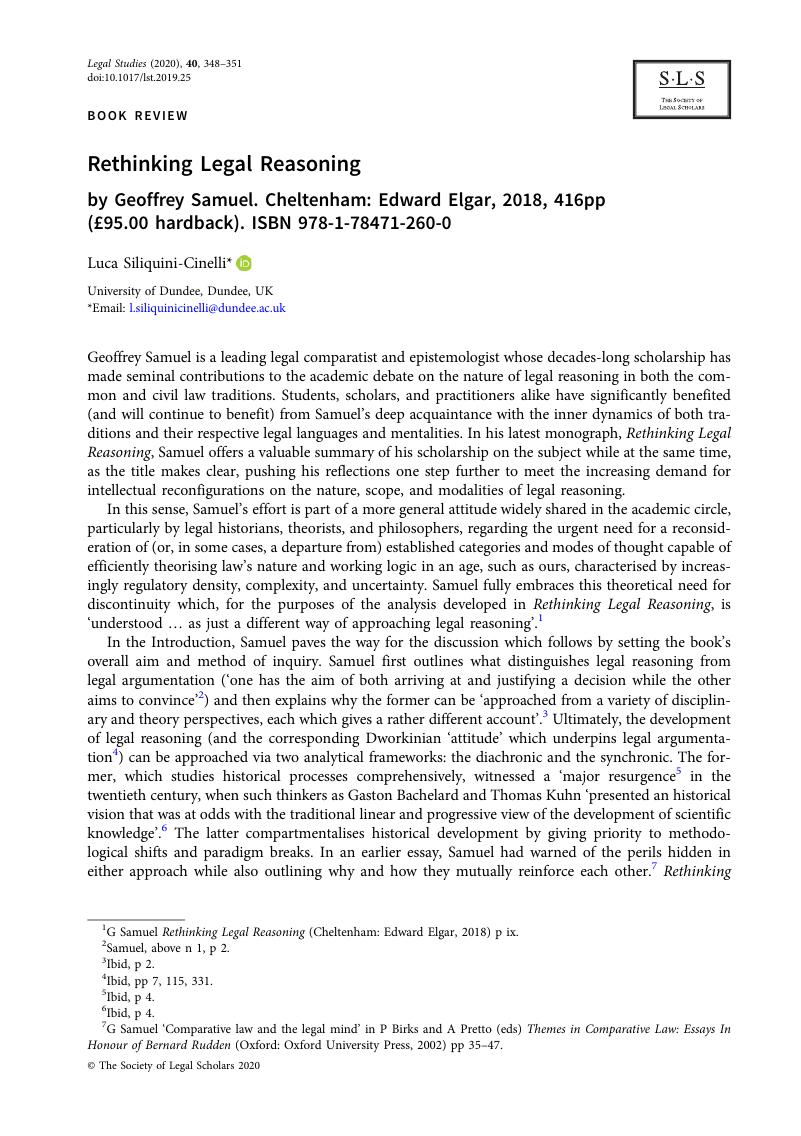No CrossRef data available.
Article contents
Rethinking Legal Reasoning by Geoffrey Samuel. Cheltenham: Edward Elgar, 2018, 416pp (£95.00 hardback). ISBN 978-1-78471-260-0
Review products
Published online by Cambridge University Press: 27 January 2020
Abstract

- Type
- Book Review
- Information
- Copyright
- Copyright © The Society of Legal Scholars 2020
References
1 Samuel, GRethinking Legal Reasoning (Cheltenham: Edward Elgar, 2018) p ixCrossRefGoogle Scholar.
2 Samuel, above n 1, p 2.
3 Ibid, p 2.
4 Ibid, pp 7, 115, 331.
5 Ibid, p 4.
6 Ibid, p 4.
7 Samuel, G ‘Comparative law and the legal mind’ in Birks, P and Pretto, A (eds) Themes in Comparative Law: Essays In Honour of Bernard Rudden (Oxford: Oxford University Press, 2002) pp 35–47Google Scholar.
8 Samuel, above n 1, p 9: ‘A diachronic approach has … much to offer. But so does a synchronic approach if one is prepared to look beyond the legal literature’.
9 Ibid, p 8.
10 Ibid.
11 Ibid.
12 Ibid.
13 Ibid, pp 12–13.
14 Ibid, pp 15, 331.
15 Ibid, pp 41–42.
16 Ibid, pp 67–70.
17 Ibid, pp 168–196.
18 Ibid, pp 258–284.
19 See in particular Samuel's statement at p 190: ‘Legal reasoning is about manipulating facts (accomodatio factorum) to make them conform in an isomorphic way with a conceptual structure implied by a legal text (statute, contract, or will) or by a precedent or line of precedents’. Samuel further explores this ‘epistemological attitude’ in chapter 9.
20 Samuel, above n 1, p 141.
21 Ibid, p 47; Samuel, GEpistemology and Method in Law (London: Routledge [2003] 2006)Google Scholar.
22 See also Samuel, G ‘Have there been scientific revolutions in law?’ (2017) 11(1) Journal of Comparative Law 186Google Scholar.
23 Ashley, KDArtificial Intelligence and Legal Analytics: New Tools for Law Practice in the Digital Age (New York: Cambridge University Press, 2017)CrossRefGoogle Scholar.
24 Samuel, above n 1, pp 8, 51–52, 166–167, 255, 272.
25 Ibid, p 160.
26 Ibid, p 285.
27 Ibid, p 285.
28 Ibid, p 87.
29 Ibid, p 88.
30 Ibid, p 87.
31 Ibid.
32 Ibid, p 107.
33 Ibid, pp 292, 306, 327.
34 Ibid, p 303.
35 Burazin, L et al. Law as an Artifact (Oxford: Oxford University Press, 2018)CrossRefGoogle Scholar.
36 Samuel, above n 1, p 1.




